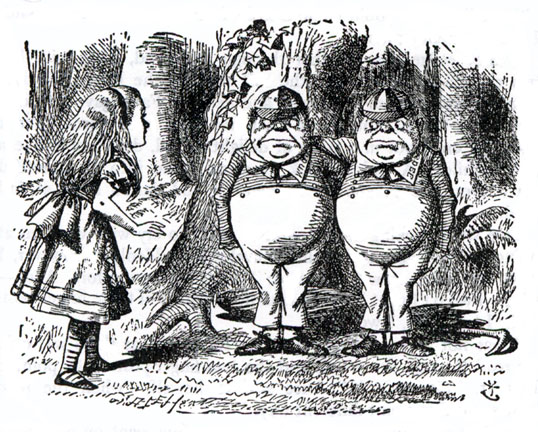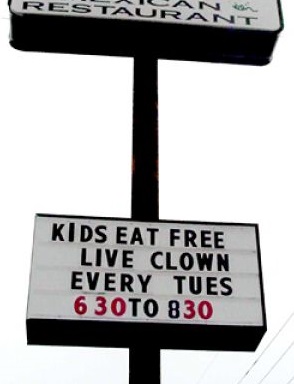Previous Month | RSS/XML | Current | Next Month
WEBLOG
March 31st, 2014 (Permalink)
A Gentle Reminder
The Fallacy Files is dependent on reader support to remain a free website. If you value it, you can help support it in three ways:
- By visiting the Google Ads in the top right corner or at the bottom of the page.
- The Fallacy Files is an Amazon associate. If you shop at Amazon, please consider doing your shopping by clicking on an Amazon link from any of these pages. By doing so, you support this site at no additional cost to yourself.
Update (2/17/2021): The Fallacy Files is no longer an Amazon associate, so please do not try to support the site by purchasing through any remaining Amazon ads.
- You can donate directly via the "Donate" button to your right.
Thank you for your support!
March 29th, 2014 (Permalink)
Headline
Utah boy discovers American Indian remains in backyard
He just won't leave!
Source: "Utah boy discovers American Indian remains in backyard", Associated Press, 3/29/2014

March 11th, 2014 (Permalink)
A Puzzle Through the Looking-Glass
and How Alice Solved It
"[I]f it was so, it might be; and if it were so, it would be; but as it isn't, it ain't. That's logic."―Tweedledee
In a clearing in the forest, Alice and the White Knight came upon the twins Tweedledum and Tweedledee. Alice recognized them from a picture book she had looked at, but she didn't know which was which. They looked exactly alike!
Alice curtsied. "How d'ye do," she said, "my name is Alice, and this is the White Knight."
"I s'pose you're wondering who we are", said the twin on the left. "I'm Tweedledee", he added, despite the fact that Alice at that moment noticed that his collar said "DUM" in big letters.
"Contrariwise, I'm Tweedledum", said the one on the right, whose collar read "DEE".
The White Knight leaned over and spoke softly in Alice's ear: "Don't trust them! At least one of them is lying. It's always that way! Sometimes both lie." The White Knight, of course, always told the truth, since he was a knight and not a knave!
"But I can tell from their collars which one each is", Alice replied.
"Oh, that!" the Knight laughed. "At night, when they go to bed, they both throw their clothes in one big pile. In the morning, they put on whatever comes to hand. So, their collars are just as likely wrong as right."
For a moment, Alice was completely at a loss how to address them, then she suddenly realized that she could figure out their names. Which twin did Alice address as "Tweedledee" and which as "Tweedledum"?
March 9th, 2014 (Permalink)
Blurb Watch: The Bag Man
Prepare for a master's class in quoting out of context. It's easy enough to craft a favorable blurb out of a pan as long as you quote only single words, CAPITALIZE THEM, AND ADD AN EXCLAMATION POINT! What's hard is to quote longer passages from a negative review and make it sound positive. But what else can you do when the movie you have to blurb has an 8% Tomatometer rating, and a Metascore of 28 for "generally unfavorable reviews"? Here's how to do it:
| Quote | Context |
|---|---|
| "Inspired by the seedy crime noir sensibility the Coen brothers brought to 1984's cult classic 'Blood Simple' or Quentin Tarintino [sic] to the brilliant bruising of 1994's 'Pulp Fiction.'
I COULDN'T STOP WATCHING." -BETSY SHARKEY, LOS ANGELES TIMES Source: Ad for The Bag Man, The New York Times, 3/7/2014, p. C14 |
There are so many good reasons to bag "The Bag Man." Where to begin? Director David Grovic…seems to be inspired by the seedy crime-noir sensibility the Coen brothers brought to 1984's cult classic "Blood Simple" or Quentin Tarantino to the brilliant bruising of 1994's "Pulp Fiction." The filmmaker is also confused by it apparently, because both aforementioned films have believable underpinnings and interesting characters who are put through their twisted paces by artists who actually have an endgame in mind. Instead, "The Bag Man"…is a brutally violent, misogynistic mind game gone wrong. … The cinematography…is going for a dark, gritty verité style. Often it's so dark you can barely tell what is on screen, which shouldn't be taken as a criticism. I'd say the film unravels at some point, but that would assume there was something there to unravel. Weirdly, I not only kept watching, I couldn't stop watching. But then I'm fascinated by train wrecks too.
Source: Betsy Sharkey, "Review: 'Bag Man' with John Cusack, Robert De Niro deserves the sack", Los Angeles Times, 2/27/2014 |
A further tip-off that this movie was poorly received by reviewers is given by the other two blurbs in the ad, one of which was taken from a review in the Culver City Observer newspaper, and the other from a blog. When ads start quoting small town newspapers and blogs, you know that the major critics panned the movie.
March 4th, 2014 (Permalink)
New Book: The Improbability Principle
Statistician David Hand has a new book out called The Improbability Principle: Why Coincidences, Miracles, and Rare Events Happen Every Day. Coincidences are important because they are the stuff of conspiracy theories and contribute to people's belief in psychic powers. People usually greatly underestimate the likelihood of such events―for an example, see Hand's discussion of the birthday paradox in Source 3, below. As a result, we often jump to causal conclusions based on chance occurrences. An example that I've discussed previously―see the Resources, below―is the argument that the so-called "fine-tuning" of the physical constants of the universe requires a causal explanation. I've no idea how Hand comes down on this issue, but I see from the index of the book―which you can see with Amazon's "Look Inside!" feature―that he discusses it, and I'm curious what he thinks.
Sources:
- David J. Hand, "It’s Not Actually a Miracle", Slate, 2/12/2014
- David J. Hand, The Improbability Principle: Why Coincidences, Miracles, and Rare Events Happen Every Day (2014)
- David J. Hand, "Math Explains Likely Long Shots, Miracles and Winning the Lottery [Excerpt]", Scientific American, 2/1/2014
Resources:
- The Arguments that Failed, 3: The "Fine-Tuning" Argument, 1/20/2009
- New Book: The Fallacy of Fine-Tuning, 6/19/2011
- Fine-Tuning the Fine-Tuning Argument, 6/27/2011
- One Universe is Enough!, 8/7/2011

March 1st, 2014 (Permalink)
Bad News About the Good News
There's some good news and some bad news. The good news is found in the following headline from The New York Times:
Obesity Rate for Young Children Plummets 43% in a Decade
Unfortunately, as too often happens, the bad news is that the good news is wrong. The headline is from a report on a CDC study of obesity rates―see Source 4, below. The bad news comes from an article by Razib Khan in Slate―see Source 2, below, and read the whole thing, it's good!
There are two main problems with the headline and its accompanying article:
- Absolute vs. Relative Measures: Here's the relevant passage from the Times report:
Federal health authorities on Tuesday reported a 43 percent drop in the obesity rate among 2- to 5-year-old children over the past decade, the first broad decline in an epidemic that often leads to lifelong struggles with weight and higher risks for cancer, heart disease and stroke. … About 8 percent of 2- to 5-year-olds were obese in 2012, down from 14 percent in 2004.
This is a confusing issue because we're dealing with percentages of percentages as well as with percentage points, which are actually an absolute measure of the difference between percentages. That is, the "plummet" from 2004 to 2012 was six percentage points, and six is about 43% of fourteen, so the drop of six percentage points is also a drop of 43% of 14%. Thus, six percentage points and 43% are ways of measuring the same change. If you're still confused, see Source 3, below. In any case, the reporter chose to emphasize the larger, more impressive number.
- Multiple Comparisons: The more important problem is that the researchers were not just looking at the obesity rate for 2-to-5-year-olds, but for different age groups―how many I do not know. As explained in the entry for the multiple comparisons fallacy, when many comparisons are made it is possible that a statistically significant result may be found just by chance. As a result, it's necessary to use a lower threshold for statistical significance in order to avoid spurious results. According to Khan, the researchers reported in the study itself not making any allowances for multiple comparisons, but the Times reporter fails to mention this. So, the six percentage point drop may well have been nothing but a chance result.
Sources:
- "Kids Eat Free Live Clown", Funny Signs
- Razib Khan, "The Obesity Rate for Children Has Not Plummeted", Slate, 2/28/2014
- Doctor Peterson, "Clarifying Percentages vs. Percentage Points", The Math Forum at Drexel, 11/21/2003
- Sabrina Tavernise, "Obesity Rate for Young Children Plummets 43% in a Decade", The New York Times, 2/25/2014
Resources:
- Check it Out, 3/31/2012.
- Geoffrey Kabat, "How Credible Is CDC's 43 Percent Decline In Obesity In Young Children?", Forbes, 2/27/2014. (Added: 3/8/2014) I didn't see this article at the time I wrote the entry above.
Fallacy: The Multiple Comparisons Fallacy
How Alice solved the puzzle: Alice knew that at least one of the twins lied, since the White Knight told her so and he never lied. So, there were only three possibilities: Tweedledum lied and Tweedledee told the truth, Tweedledee lied and Tweedledum told the truth, or both lied.
However, Alice realized that it was impossible that just one of the two lied: let's suppose that the twin on the left lied and the one on the right told the truth―the other case would be much the same. If the one on the left lied when he claimed to be Tweedledee, then he must be Tweedledum. However, the brother on the right truthfully claimed to be Tweedledum. Since it's impossible for both boys to be Tweedledum, it can't be the case that only one lied. Therefore, both lied.
Now, if both lied, then the solution is obvious: each brother is the opposite of what he claimed to be. So, Alice correctly addressed the twin on the left as Tweedledum and the one on the right as Tweedledee.
Sources:
- Lewis Carroll, Through the Looking-Glass and What Alice Found There, Chapter 4: "Tweedledum and Tweedledee"
- Martin Gardner, Wheels, Life and Other Mathematical Amusements (1983), pp. 77, 82-83